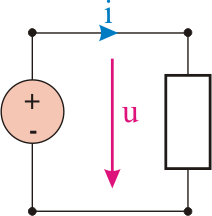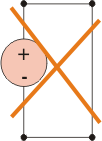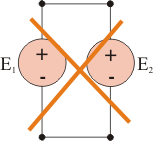An ideal, independent voltage source is a dipole which has the capability to impose a potential difference between its terminals, regardless of the current that flows through it.
The equation that characterizes an ideal voltage source is:

where, generally,  is called the electromotor force of the source.
is called the electromotor force of the source.
In the case of a direct voltage source (DC),  has a constant value.
has a constant value.

Figure 1 - Examples of continuous voltage sources
The symbols most frequently used for representing a voltage source are:
| General symbol for voltage sources |
Direct voltage source (DC) |
Alternating voltage source (AC) |
| |
 |
|
Figure 2 - Symbols of voltage sources
When we connect a voltage source with another passive element, we obtain a circuit in which the current  flows.
flows.

Figure 3 - Ideal voltage source supplying a passive element
However, the current provided by the voltage source depends on the elements it supplies:
• a voltage source can be left in an open circuit, respectively without any connection to its terminals. In this case, the current  supplied is zero, and therefore also the power
supplied is zero, and therefore also the power  provided is zero;
provided is zero;
• the terminals of an ideal voltage source can not be linked between them by an ideal conductor (short-circuited), because this situation corresponds to the annulment of the generator's voltage; while a voltage source means that  , a short-circuit means
, a short-circuit means 
• two voltage sources can be parallel connected only if the electromotor forces are equal; thus, by applying Kirchhoff's 2nd Law we obtain  , which leads to the conclusion that the two electromotor forces are equal.
, which leads to the conclusion that the two electromotor forces are equal.
 |
 |
 |
Figure 4 - Ideal voltage source in open circuit, in short-circuit and two voltage sources parallel connected